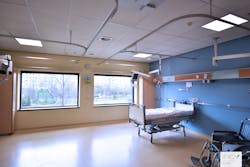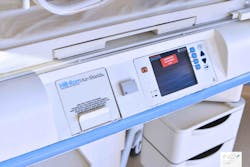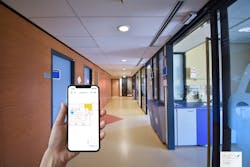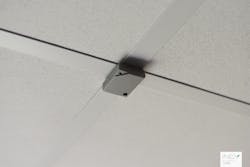Holland’s University Medical Center (UMC) Utrecht is a huge place. With around 70,000 rooms spread across some 6 million ft2, portable equipment of all shapes and sizes gets misplaced — beds, infusion pumps, blood pressure monitors, wheelchairs, you name it.
“They go missing,” says Thijs Dijkgraaf, a clinical informatician at the hospital and research center. “Things are not in the right place at the right time.”
It’s a problem that is probably familiar to hospitals around the world. At UMC, the situation can be so acute that staff members sometimes stash away certain items in secret hiding places, even in ceiling panels. That’s fine for the nurse who knows where to fetch the blood pressure monitor, but it’s not so good for the many others who don’t. Not only can unavailable equipment create care problems, but it’s costly, too. Lost property requires money to replace.
And even if an item is not really lost, the amount of time that it takes to find it can strain financial budgets. Another detriment is that missing equipment undermines routine hardware maintenance and inspection schedules. If an infusion pump is due in for its yearly check, it doesn’t help if the pump is nowhere to be found.
Indeed, stray equipment is a well-known issue in the healthcare industry and one in need of a solution. Dijkgraaf and his colleagues at UMC now think they have found one in the form of smart lighting outfitted with radio chips that keep track of where the goods are.
In March of this year, UMC began running a proof-of-concept trial, clearing patients from one floor in a wing where it put radio tracker tags on hospital equipment that stayed in touch with radio-enabled lights. The trial covered about 1500m2, including 15 patient rooms of different sizes, as well as multiple treatment rooms, exam rooms, common rooms, and storage closets. The hospital lit the space with about 50–100 Koopman Interlight LED luminaires outfitted with chips from Amsterdam-based smart lighting startup Ingy. The communication between the roaming assets and the fixed-point lights pinpointed the asset’s location, which the luminaires then transmitted wirelessly to an information technology gateway wired to the hospital’s IT network, overseen by systems integrator Fujitsu.
Central staff was then able to check the system to spot the whereabouts of a missing item. System users can access the asset tracking functions via a smartphone app. The idea was that support staff could find the items and put them back in their proper place, such as a designated storeroom or cupboard, where doctors, nurses, and medical technicians would easily find them. UMC vacated the area of any clinical operations because it also needed to check the possibility that the radio communications would interfere with electronic medical equipment.
With the trial having run for a few months now, the verdict is in.
“It’s been great,” said Dijkgraaf. “You can get the status of medical equipment. We know if it’s available, if it’s maintained, if it’s in stock. It all helps the staff in the hospital to use the equipment in a timely manner.”
The lighting-based asset tracking system represents a huge improvement over previous methods that relied on manual data entry into a facilities management system, and on, as Dijkgraaf described it, “generating lists and walking around making lots of phone calls.”
The trial also showed promise beyond asset tracking, as the smart lights were fitted with sensors feeding occupancy data back to the facilities management team, which could analyze how well a particular room or area is being utilized — potentially a huge benefit in the sprawling complex full of patient rooms, treatment rooms, classrooms, conference areas, and so forth. Other light-embedded sensors provided air quality measurements. And the lights also delivered indoor navigation to help direct staff or visitors to a pinpoint location within the facility. They helped staff initiate actions such as ordering a cleaner or requesting a bed.
Going live
With the positive findings from the pilot, as this story was going to press, UMC was setting up additional pilots of the smart lighting system, according to UMC facility management project director Wiko Lamain, noting that the next trials would be within clinical areas of the hospital, not just in a cleared-out test area.
“It’s quite a big hospital, and sometimes it’s quite difficult to find one or two instruments to maintain them or to use them,” said an optimistic Lamain. “This will make it easier for nurses or medical engineers to do their work.”
Using network-linked radio chips and sensors to make it easier for medical workers to get on with their jobs certainly sounds like a good idea. But it also sounds like the purview of an IT company rather than of a lighting company.
And, in the case of UMC Utrecht, it is. The main contractor on the job is Fujitsu, which is ultimately responsible for the hospital’s core network and database. But it is notable that Fujitsu — working with subcontractor Ingy — chose to use the lighting infrastructure to house many of the system’s chips and sensors.
While some of the chips and sensors will indeed reside outside of the lighting, many of them will be embedded inside the luminaires, where they can draw on the same electricity supply that powers the luminaire rather than rely on problematic batteries, Fujitsu’s Dennis van Doorn explained. Ceiling luminaires also provide ready-made dense coverage of the hospital area, added van Doorn, who is marketing manager for wireless solutions at Fujitsu Components Europe.
That all makes eminent sense to the hospital. “It’s quite simple,” said Lamain. “If we use sensors on batteries, we have to change all the batteries every couple of years and it will take up a lot of time as well. By combining it with the lights, we have sensors, and we have coverage all over the hospital.”
Ingy CEO Bastiaan de Groot put another perspective on it, noting that without using the lights to house beacons, each room would need an independently-mounted, battery-powered beacon. And if the medical center wishes to fully outfit its patient facilities, it would need 70,000 such beacons across its 70,000 rooms. “And that,” noted de Groot, “would screw up the business case.”
“We have 550,000m2, divided over multiple buildings,” added UMC’s Dijkgraaf. “It’s quite a complex environment to install any equipment, so if we can install lights and do asset tracking with them, it seems very interesting.”
Lighting meets information technology
The cooperation between Fujitsu and Ingy is one way in which the lighting industry and IT industry might relate to each other as each chases what could be a bonanza in making buildings smart. As the lighting industry tries to morph into playing the role of IT provider — such as what Gooee is doing with as many as 5000 buildings in Holland — it will find itself both competing with and, as in the case of Ingy at UMC, cooperating with the IT industry.
In fact, Ingy’s general business strategy calls for partnering with data and IT companies that can handle the analytics of data collected by the smart lighting equipment provided by Ingy. Ingy’s two-part modus operandi is to help luminaire companies such as Koopman sell Ingy-equipped LED luminaires that make a facility ready-to-go as a smart building if and when the building operator decides to go that way. Ingy hopes to sell the smart building portion directly as a service, once the customer decides to switch on the intelligent features.
The partnership with Fujitsu at UMC came about when both Ingy and Fujitsu were pitching separate projects that shared a common thread. Ingy was talking to UMC about upgrading its lighting to smart-ready luminaires, while Fujitsu was simultaneously pitching asset tracking to the hospital.
“We at Ingy were already talking to the facility maintenance guys about replacing the lighting and making it IoT ready, while at the same time Fujitsu was already talking to the IT guys,” Ingy’s de Groot recalled. “Dennis [van Doorn] and I knew each other. We brought the IT departments and the lighting department together. I think it’s safe to say that the IT people barely knew the people that would normally talk about lighting. It took a while to connect the two departments, but Dennis and I made the introductions.”
Wirepas wireless protocol
The alliance between Ingy and Fujitsu was also a natural one in the sense that both de Groot and van Doorn are enthusiasts of Wirepas, the proprietary wireless mesh protocol that de Groot has praised for its ability to scale up across thousands of lights, and also for its ability to handle multiple functions, including asset tracking. Wirepas uses Bluetooth radio chips designed by semiconductor company Nordic, but applies an entirely different and proprietary protocol for mesh networking compared to Bluetooth mesh. Wirepas is the mesh technology that security giant Securitas is using at a life sciences research park in Sweden, as LEDs Magazine featured in our last issue. At UMC, some of the functions are straight-up Bluetooth, such as indoor navigation which uses Bluetooth beacons, and wireless wall switches which are EnOcean Bluetooth products.
“That’s how Bastiaan and I know each other,” said van Doorn. “We are both in this ecosystem around Wirepas.”
Now the two vendors are in a business relationship in which UMC pays Fujitsu as the main IT contractor, and Fujitsu pays Ingy a service fee for collecting data that supports asset tracking as well as indoor navigation, occupancy analytics, air quality, and task requests such as calling for a cleaner. While Ingy embeds the radio chips and sensors in Koopman lights, in some instances at the hospital it will mount them outside of the lights, such as in operating rooms and quarantine areas where the hospital maintenance team might not want to mess with lighting.
The hospital purchases the luminaires straight from Koopman but pays a service fee to Fujitsu once it starts using the IT features of luminaires.
Ingy itself does not handle the analytics, which sometimes happens in the cloud and sometimes within a closed UMC system. In cases where it goes to the cloud, Systematic handles asset tracking and task management data, and Gooee handles climate monitoring and occupancy analytics. The data is owned by UMC.
What really matters is the benefit to UMC, which sees plenty of potential. For instance, Dijkgraaf estimates that the hospital will cut down on purchases of new infusion pumps by 20% not only because it will be able to better locate them, but it will also avoid purchases to replace pumps for which maintenance records have become unreliable.
Patients should also benefit. “When we get a child in in the middle of the night, you want to find a junior bed, and you don’t want to have to look for it,” said Lamain. “You want to know exactly where the nearest available bed is.”
The same applies for infusion pumps, blood pressure monitors, and all those other things that go missing, sometimes because staff members hide them way. Soon the nurses, technicians and doctors won’t have to peek behind ceiling panels. They can simply look to the lights.
MARK HALPER is a contributing editor for LEDs Magazine, and an energy, technology, and business journalist ([email protected]).








